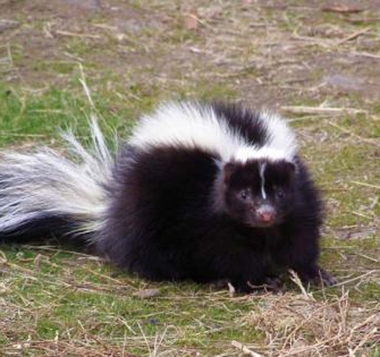Researchers identify compound that neutralizes skunk odor

The pungent smell of the spray associated with skunks has inspired countless home remedies over the years, including tomato juice, hydrogen peroxide and baking soda. But researchers at the University of Oklahoma (OU) have identified a compound from fungi that safely and effectively neutralize skunk spray odor.
OU Regents’ Professor Robert Cichewicz and his team at the Natural Products Discovery Group (NPDG) previously identified a fungi, called pericosine A, and wondered how it would react with the chemicals in skunk spray. Different compounds from the skunk spray were each mixed with pericosine A, and two were neutralized by the fungi.
Then, the team slightly altered the structure of pericosine A and adjusted other ingredients in the reaction. That change produced a formula that would be safer and more effective for skin application following a skunk attack.
“We have laid the foundation for how one would go about using it and have provided an initial assessment of its safety,” said Cichewicz. “We are looking forward to seeing how it could be used commercially.”
The team published their findings in a recent edition of the American Chemical Society’s Journal of Natural Products.
Q&A with Dr. Cichewicz:
1. How long ago did you identify pericosine A? Was it submitted through the Citizen Science Project? Work-related to these studies was first reported by us in 2013. The original fungus was identified as a Tolypocladium species from a citizen scientist living in Salcha, Alaska.
As research went on, we came to appreciate that the fungus was making pericosine as a defensive metabolite to protect itself from noxious chemicals in its environment. That led to the current line of thinking that if pericosine could be used by fungi to protect themselves from toxins and other problematic chemicals in its environment, then could humans use it too?
Skunk scent seemed to us to be the perfect test case – the compound is extremely noxious (smelly) to humans. If we could tackle that problem, the other odors seemed reasonable targets.
2. Who was the lucky researcher who got to smell the skunk spray over and over? Or was the reaction observed differently? Lin Du did most of the chemistry research; however, we also worked with Dr. Doug Franz at UT, San Antonio, and his student Charissa Munteanu.
We did not conduct human studies. However, when working with such incredibly smelly molecules, it becomes apparent what is and is not working before you analyze the samples.
3. Is there more testing to be done about skin sensitivity, etc., in your lab, or does the commercial application testing go through the company that might develop it for sale? Yes, lots more tests, but we have advanced it in a meaningful way to show the compound has many desirable properties and has a reasonable chance of ultimately being proven safe for dermal [skin] use.
At this point, we are hoping to find an interested and knowledgeable partner to help drive this technology toward commercialization. This is a unique and promising molecule with lots of potential to neutralize odors, but we also recognize we are scientists and other people are better trained, knowledgeable, and have the financial resources to translate our discoveries into a product that people can use.
We hope to identify those partners and work together to bring this technology from the university and into public use.
4. Anything else? We are very excited to see pericosine move forward, but all this work would not have happened without the great help from citizen scientists and lots of wonderful and curious people working on testing this natural products properties and potential applications.
We are very excited to play a role in furthering the application of natural products to helping solve problems in people’s lives, while also training scientists. Collaboration has been critical to making this project work, and we look forward to continuing the project with our team to learn more about this fascinating class of fungal natural products.
The NPDG Lab uses a variety of chemical and molecular research methods for converting chemicals found in nature into compounds that can improve people’s lives. The lab is known for the “What’s In Your Backyard” program, providing citizen scientists an opportunity to send in samples from their dirt at home to see if any compounds can be isolated to help cure disease.
Science Museum Oklahoma hosted an exhibit of the lab’s work in their “Decomposition: Discovering the Beauty and Magnificence of Fungi” in 2018.
The Gayly. 8/13/2019 @ 3:12 p.m. CST.





